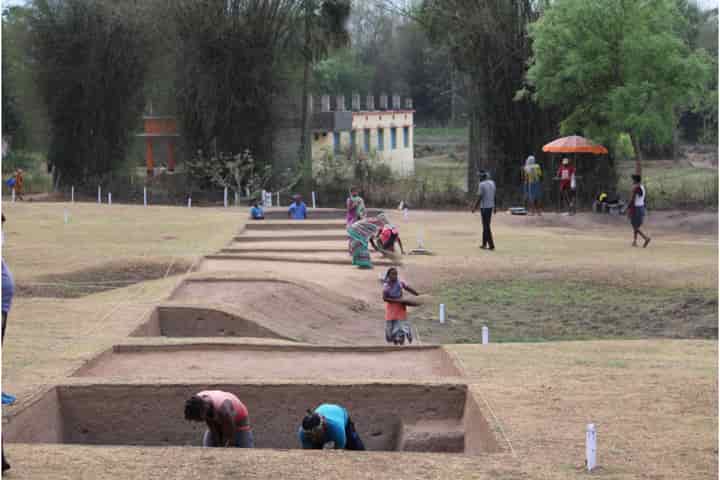

The excavation site in Durgadevi village of Odisha, which has brought to light significant historical objects and findings about the area
<p>
<strong>From the point of historical find, it is truly a treasure trove as it throws light not on one but three phases of culture of the land. That is what the archaeological excavation at Durgadevi village which is located in Odisha&rsquo;s coastal Balasore district has revealed.</strong></p>
<p>
It reveals details about three phases of cultural evolution, which are <a href="https://www.newindianexpress.com/states/odisha/2021/jul/03/three-periods-of-ancient-ages-unearthed-in-durgadevi-village-of-odisha-2324893.html">continuous and systematic phases</a>, over a period of 2,000 years. The period it covers is from 2000 BC to 100 BC.</p>
<p>
The digging and the examination was done by the Odisha Institute of Maritime and South East Asian Studies (OIMSEAS). The Institute which comes under the Department of Culture, Odisha Government, has discovered traces of Chalcolithic phase (2000 to 1000 BC), Iron Age (1000 to 400 BC) and Early Historic period (400 to 200 BC) in the village.</p>
<p>
Apart from this, also discovered were traces of fortification of the entire early historic site and materials related to the three periods.</p>
<p>
<img alt="" src="https://www.indianarrative.com/upload/news/Durgadevi_Odisha_village_digging2.jpg" style="width: 720px; height: 480px;" /></p>
<p>
Work by the OIMSEAS commenced at Durgadevi, a village which is located 20 kilometres from Balasore and borders Mayurbhanj, in March 2021.</p>
<p>
The Institute&rsquo;s work in the area brought to light a mud fortification which is circular, and further that this fortification is surrounded by rivers, namely on south by Sona and on north-east by Budhabalanga.</p>
<p>
Interestingly, two nullahs of the village Gangahara and Prassana join this site on the north and south side, thereby creating a natural moat. It is an ancient water management system, which was developed 4,000 years back.</p>
<p>
<strong>Also read: <a href="https://www.indianarrative.com/culture-news/year-old-burial-sites-in-telangana-need-a-saviour-97415.html">3,500-year-old burial sites in Telangana need a saviour</a></strong></p>
<p>
Talking to New Indian Express, Dr Sunil Kumar Patnaik, Chief Archaeologist and OIMSEAS secretary said: &ldquo;People depended on the nullahs for agriculture, fishing and daily uses. The rivers were the route of maritime trade.&rdquo;</p>
<p>
Comprising four hamlets — Sutanatei, Mahasayapatna (Mausipatana), Kudia and Durgadevi &ndash; the village has 500 households. The village as well as the hamlets are all situated with the fortified ancient enclosure.</p>
<p>
Excavations were carried out at the horizontal level in three trenches which are spread over two acres of high land.</p>
<p>
<img alt="" src="https://www.indianarrative.com/upload/news/Durgadevi_Odisha_village_digging3.jpg" style="width: 720px; height: 480px;" /></p>
<p>
Among the important discoveries was the base of a circular hut, copper objects and black on red painted pottery, all from the Chalcolithic period. According to Patnaik, the discovery of the hut and the utilitarian objects brings to light that those who were living here were leading a settled life thus indicating practice of agriculture and domestication of animals and fishing.</p>
<p>
Also among the discoveries were pottery remains and iron items like nails, arrow head, crucible and varied kinds of slag.</p>
<p>
Patnaik informed NIE that &ldquo;the use of iron is a landmark phase in the growth of civilisation in Odisha, particularly North Odisha. There are several Iron Age sites discovered by various archaeologists in upper and middle Mahanadi valley but this is the first site in North Odisha.&rdquo;</p>
<p>
Likewise, also discovered were objects of the Early Historic period. These include specimens of pottery of red, black and grey ware, terracotta ear studs, bangles, beads, terracotta wheels and some conical objects. This can be taken to indicate the transition from an agricultural base to trade.</p>
<p>
<strong>Also read: <a href="https://www.indianarrative.com/culture-news/key-digitally-restored-painting-spotlights-india-s-ancient-tradition-91410.html">Key digitally restored painting spotlights India&#39;s ancient tradition</a></strong></p>
<p>
Patnaik pointed at another significant aspect stating that this was the time when fortification around the site with the natural moat began. This he said indicates the emergence of urbanization at Durgadevi around 400 to 200 BC.</p>
<p>
In order to pinpoint the exact dates of the site, samples of the objects have been sent to New Delhi&rsquo;s Inter-University Accelerator Centre.</p>
<p>
While till now only the first phase of the excavation has been completed, a period of three years will be required to comprehend different aspects of the ancient site.</p>
Union Commerce and Industry Minister Piyush Goyal has urged exporters to create a facility that…
Foreign Secretary Vikram Misri met Under Secretary Jeffrey Kessler on Wednesday and discussed advancing India-US…
An exhibition, titled 'Rihla-e-dosti' celebrating "over 250 years of friendship" between the regions of India…
India's coal imports fell by 7.9 per cent, totalling 243.62 million tonnes (MT), compared to…
At least 88 illegal Bangladeshi migrants have been traced and detained by teams of South…
Japan has accused China of conducting maritime scientific research without prior notification within its exclusive…